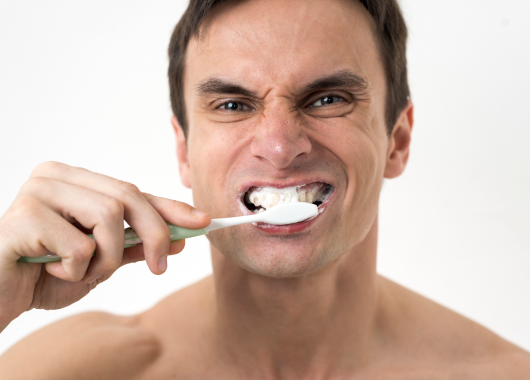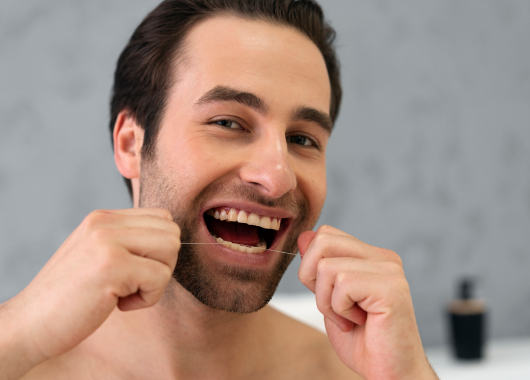Brushing vs. Flossing: Which One Matters More?

When it comes to keeping your teeth healthy, brushing and flossing are the two most
important habits to adopt. But which one is more crucial? Is brushing enough, or does
flossing deserve more attention? Let's dive into the debate and uncover which of these
dental practices truly takes the crown for oral health.
Brushing: The Foundation of Dental Care
Brushing is often considered the cornerstone of oral hygiene. It's what most of us learn
from an early age, and it's usually the first step we take to maintain a clean mouth.
Brushing helps remove plaque—the sticky film of bacteria that builds up on your teeth
and can lead to cavities and gum disease.
Why Brushing Matters:
- Removes Plaque: Brushing scrubs away plaque from the surfaces of your teeth, helping to prevent cavities and keep your enamel strong.
- Fights Bad Breath: It freshens your breath by removing food particles and bacteria that cause odor.
- Protects Your Enamel: Using fluoride toothpaste helps to strengthen tooth enamel, making it more resistant to decay.
How to Brush Correctly: Brush for two minutes, twice a day, using a soft-bristled toothbrush. Make sure to reach all areas, including the front, back, and chewing surfaces of your teeth.
The Limitations: Although brushing is essential, it only cleans about 60% of your tooth surfaces. The bristles can't reach the spaces between your teeth, leaving bacteria and food particles behind.
Flossing: The Unsung Hero
Flossing often gets overlooked, but it's just as important as brushing. In fact, it addresses the areas that your toothbrush simply can't reach—between the teeth and under the gumline.
Why Flossing Matters:
- Removes Hidden Plaque: Flossing removes plaque and food particles lodged between your teeth, which helps prevent gum disease and cavities.
- Protects Your Gums: By cleaning under the gumline, flossing reduces the risk of inflammation and gingivitis.
- Improves Breath: It eliminates food particles that brushing misses, which can otherwise cause bad breath over time.
How to Floss Correctly: Floss gently between each tooth, sliding it up and down to remove plaque and debris. Aim to floss once a day, preferably before bedtime.
The Limitations: Flossing can be tricky for beginners, and improper technique can cause gum irritation. It also takes more time and effort than brushing, which is why many people skip it altogether.
Brushing vs. Flossing: The Face-off
Now that we understand the benefits of each, let's compare brushing and flossing to see which one is more essential:
1. Plaque Removal:
- Brushing effectively removes plaque from the visible surfaces of your teeth.
- Flossing targets the plaque between teeth and under the gumline.
Winner: Tie. Both are crucial for complete plaque removal.
2. Preventing Gum Disease:
- Brushing helps keep gums clean but can't reach the spaces where gum disease often starts.
- Flossing directly cleans these hard-to-reach areas, preventing gingivitis and periodontitis.
Winner: Flossing takes the lead here, as it's better at preventing gum issues.
3. Breath Freshness:
- Brushing provides immediate freshness but doesn't remove all odor- causing particles.
- Flossing reaches food debris stuck between teeth that can cause bad breath.
Winner: Brushing wins for instant freshness, but flossing ensures long-term breath control.
The Truth: They Work Best Together
 Brushing and flossing aren't competitors—they're a team. Brushing handles the larger
surfaces of your teeth, while flossing takes care of the tight spaces between them.
Together, they offer complete protection against plaque, cavities, and gum disease.
Brushing and flossing aren't competitors—they're a team. Brushing handles the larger
surfaces of your teeth, while flossing takes care of the tight spaces between them.
Together, they offer complete protection against plaque, cavities, and gum disease.If you had to choose just one (not recommended), flossing might be slightly more important for preventing gum disease. But for a truly healthy mouth, you need to do both. Brushing without flossing is like washing only part of your body in the shower—not exactly effective.
Why You Shouldn't Skip Either
Skipping either brushing or flossing can lead to problems:
- Cavities: Brushing removes plaque from your teeth's surfaces, but bacteria between teeth can still cause decay if you don't floss.
- Gum Disease: Flossing is essential to keep gums healthy, but it won't be as effective if you neglect brushing.
The American Dental Association recommends brushing twice a day and flossing once daily. Together, they offer the best defense against dental problems.
Tips for a Better Routine
- Brush Properly: Use a soft-bristled toothbrush and fluoride toothpaste. Replace your brush every three months.
- Floss Gently: Use about 18 inches of floss, wrapping it around your fingers and sliding it between teeth without snapping.
- Use Mouthwash: For extra protection, consider using an antibacterial mouthwash after brushing and flossing.
Conclusion:
In the end, the battle between brushing and flossing is a bit unfair—they're not meant to compete but to complement each other. Brushing cleans most of your teeth, while flossing finishes the job by reaching the hidden spots. By combining both, you ensure a thorough clean that keeps your teeth strong, your gums healthy, and your breath fresh.
So, the next time you think about skipping flossing because you brushed really well, remember: a truly healthy smile needs both. Give your teeth and gums the attention they deserve, and you'll enjoy a bright, confident smile for years to come.
